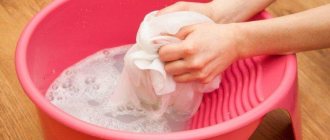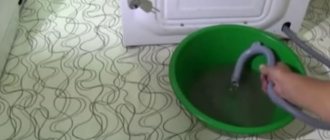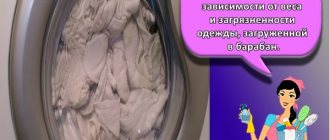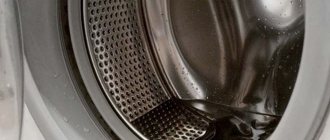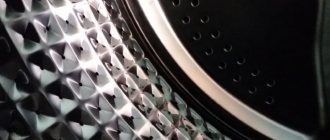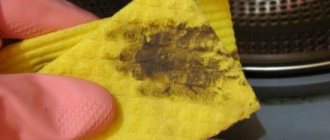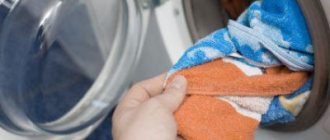When the washing machine has nothing to do with stains
There are many situations when a washing machine from LG, Samsung or another brand has nothing to do with stains on things, because their appearance is associated with erroneous user actions. This could be an incorrectly selected powder, incorrect loading of laundry, an incorrectly installed program, etc.
- If colored spots appear on light-colored laundry, this means that items of different colors were washed together and during the program the brightly colored fabrics faded under the influence of high temperature. To avoid such situations, you need to wash colored and light-colored items separately, and if you still have to do this together, then set the temperature to no more than 40°C.
- If red or brown spots appear on things, this may be a sign of rusty water in the plumbing. If the problem occurs constantly, you need to install a filter at the entrance to the washing machine. Another cause of such stains could be a rusty dryer. The device needs to be cleaned of rust or replaced.
- Purple spots or the appearance of a lilac tint on light-colored items means that a color corrector powder was used. It allows you to eliminate the yellowness of fabrics and whiten things, but if the linen was without a yellow tint, then the corrector gives it a purple or bluish tone. If a lot of powder is poured in or the temperature is incorrectly selected, the color corrector does not dissolve well and forms stains. In order not to spoil your laundry, you must use regular washing powder.
- White spots and stains, especially noticeable on dark clothes, indicate that a lot of detergent was added or the washing machine was overloaded. To prevent such situations, you must adhere to the dosage of the powder, and also not exceed the permissible load of the equipment.
- Yellow stains after washing on light-colored laundry are traces of grease that become noticeable after contact with hot water. To remove them, you need to soak things, use stain removers, detergent enhancers, and powders with enzymes that effectively remove traces of grease.
- If white or yellow spots appear on silk or woolen items, down jackets or jackets, or sportswear after washing, this indicates that the detergent was chosen incorrectly. Only use appropriate detergents and set the program correctly. If the chemistry and mode are chosen correctly, it is necessary to add another rinse during the subsequent wash, because The detergent is not completely washed out of the fabrics.
- If dirt stains appear on items after washing, this may mean that they appeared after washing during drying. Children, animals, or adults themselves could have smeared the laundry by touching it with dirty hands.
What stains can you encounter?
Housewives who have been doing laundry for many years have probably encountered many types of multi-colored stains that an automatic machine can leave. But their origin is most often the fault of the owners of the equipment themselves, who did not provide proper care for the unit.
The list of the most common contaminants is as follows:
- colored spots on white and light-colored things;
- rusty, brown, red or orange;
- blue, purple, lilac;
- white stains on black clothes;
- yellow spots on white things;
- yellow on silk, wool, jackets;
- oil dark, gray;
- dark and black spots.
Why does the washing machine get dirty?
Gray, black or dark spots on clothes indicate that the owner of the washing machine does not maintain the equipment. Due to lack of care, dirt and mold form in the folds of the hatch cuff, in or under the detergent drawer, as well as in the drain filter.
Dirty cuff
If the washing machine is not properly maintained, a thick layer of gray dirt appears in the folds of the hatch cuff, as well as under it. When you touch it, things become smeared and unpleasant marks appear on them. You can clean the cuff using brushes and a cloth. You need to act carefully so as not to damage the rubber. It is not recommended to use
Mold in the tray
If the user does not regularly rinse the cuvette, does not open it after washing to dry and slams the hatch door, this leads to dampness inside the washing machine and, as a result, to the appearance of mold. In addition to contaminating laundry, it can negatively affect human health. You can detect mold by the specific smell inside the washing machine drum.
Mold deposits can be everywhere: in and under the detergent drawer, on the cuff, in the drum, pipes, at the top of the tank walls.
To get rid of mold, you need to pour baking soda into the powder cuvette, set the temperature to high and an additional rinse, and start the wash. If you cannot remove it the first time, you will need to repeat the procedure.
Contaminants in the drain system
A dirty drain filter can also cause mold. In washing machines with a standard drain pump, it spreads an unpleasant odor, and in expensive appliances with a recirculation pump it also leaves stains on the laundry. To avoid this problem, you should clean the drain filter regularly. You will also need to disassemble the washing machine and rinse the tube connecting the pump to the tank under a powerful stream of water. Dirt also accumulates in it, which is not washed out even when cleaning the device with citric acid or chemicals.
The “culprits” for the appearance of stains on clothes
Repairers of washing units note that there are more than a dozen reasons why a machine can dirty things. They are all divided into:
- serious - associated with malfunctions in the machine itself;
- of a simple nature - caused by violations of the rules for operating household appliances.
Simple factors for the appearance of pollution
- Drum overload. You can put the maximum amount of laundry in the washing machine allowed by the manufacturer. Otherwise, the washing powder will get into the folds of clothes and be difficult to wash out of them. This will lead to the appearance of light orange or red spots, which are unlikely to get rid of without additional rinsing.
- Incorrect amount of powder.
- Weak water pressure. This leads to the fact that the powder from the compartment is poorly washed out at the beginning of the cycle and gets into the process already during rinsing.
- Leaving laundry in the drum for a long time after the end of the cycle can lead to the appearance of a musty smell and light stains on things.
- Kalgon. Store-bought descaler can settle on laundry (especially white fabrics) and cause yellow stains. Avoid such chemicals and use, for example, citric acid instead.
- Bleach. If you violate the dosage of chlorine-containing products, you will definitely see white spots on your laundry when you take things out of the drum.
Eliminating the above reasons that lead to flaws is as easy as shelling pears. Enough:
- increase the water pressure to better rinse clothes from detergent;
- put the powder not in a special compartment, but directly to the laundry, in a drum container;
- buy and use liquid detergents that do not leave dark, light or any other stains on clothes.
Expert opinion
Vasily Mikhailovich
Ask a Question
Constant use of liquid detergents can lead to the formation of mold and slime on rubber seals and other parts of the unit.
- When using bleach, strictly follow the dosage recommended by the manufacturer and use the additional rinse function.
Other factors causing stains
Have you checked everything, but haven’t found the reasons described above why things get dirty due to the fault of the machine? Most likely, we are talking about problems of a more serious nature:
- Seal failure. The appearance of greasy stains on the fabric is a clear sign of its breakdown. When the unit operates, the oil seal lubricant gets onto the laundry and stains it. The malfunction can be eliminated by replacing the part.
- Bearing failure. Recognizing the problem is quite simple: the machine begins to make a lot of noise during the spin cycle, and gray or blue smudges remain on the products. To avoid trouble, you should change the seals on time, and also wash them less often at a temperature of 90 degrees.
- Dirt on and under the rubber cuff. When starting the machine, it can get into the drum and stain the laundry. Brush the cuff regularly and wipe dry after each cycle.
- Fungus on the drum or pipes. The characteristic musty odor of mold and mold will help identify the problem. The main reason for the appearance of fungus is the tightly closed machine door at the end of the wash. Do not close the hatch immediately after turning it off and let it dry. Has the fungus already appeared? An idle cycle with the addition of soda or a small amount of citric acid will help get rid of it.
- Dirty water. Have you taken things out of the drum and still have rusty stains on them? Most likely, the problem is in water with a high iron content. The latter penetrates into the fibers and, oxidizing in the air when the laundry dries, turns into red stains. A special filter for the machine will help you cope with the problem. You can also try draining the tap water for 10-15 minutes before starting the unit.
- Drain hose or filter clogged. Foreign objects (accessories from things, small particles) often get into them, which lead to negative consequences. By cleaning the filter and hose, you can quickly solve your stain problem.
Problems with the washing machine
A number of problems with the washing machine can cause stains to appear on clothes.
Oil seal problem
If the washing machine stains the laundry and oil stains appear on it, this indicates damaged seals. During operation, they are deformed, water penetrates the seat with the bearing and washes away the lubricant. The latter spoils things, and the bearings become deformed due to increased friction. This problem should be solved urgently, otherwise it will lead to damage to the washing machine. Replacing bearings and seals is a complex and time-consuming process that should be entrusted to professionals.
Foreign mechanical objects in the tank
During washing, various metal objects sometimes penetrate into the drum, and from it into the tank of the washing machine. These could be coins, bobby pins, nails, etc. They remain at the bottom of the tank, become covered with a layer of rust and pollute the water. After washing in such a liquid, rusty, yellow or brown spots appear on the laundry. Extraneous noise during operation of the washing machine also indicates the presence of a foreign object. To fix the problem, you need to remove the extra item from the tank.
Signs of low-quality washing powder
Using low-quality detergent for washing is a common cause of stains and dirt on clothes. When choosing a washing powder, many take into account only the type of washing machine, without paying attention to other criteria. It is often possible to notice the low quality of the powder only during washing based on a number of signs.
See also
Step-by-step instructions on how to properly assemble a child car seat after washing
Does not dissolve in water
Powder granules should dissolve during washing, regardless of the water temperature. If the quality of the product is poor, the granules do not dissolve enough in cold or warm water and leave stains on clothes.
Gives foam
The formation of foam during washing indicates good dissolution of the powder. If the powder creates a minimal amount of foam, this may affect the wash result.
It is also important to know that a number of modern detergents have reduced foaming, so in this situation the amount of foam is not related to the quality of the powder.
As a rule, high-quality and more expensive washing powders foam well and effectively remove dirt from fabric surfaces of any type. Modern manufacturers of detergents often add conditioner to the powder, which creates a double effect from washing things. As a result, clothes do not require additional processing and become clean and pleasant to the touch.
Smell
High-quality washing powder has a neutral, faint odor. The presence of an unpleasant odor occurs after the expiration date, when storage conditions are violated and mold forms. If immediately after opening the package or over time the washing powder acquires an unnatural odor, it is recommended to refrain from using it and purchase a new detergent.
How to remove stains
If you know how to remove stains, removing them after washing will not be a problem.
- Rust stains on linen can be removed with vinegar or lemon juice. The stain should be thoroughly wiped with this product and then rinsed with warm water.
- Ammonia effectively removes grease stains.
- Chalk and soap help remove grease and fuel oil stains from laundry. These substances are mixed, water is added, applied to the dirt and left for an hour, after which it is washed off.
How to get rid of streaks and white residue on things
When washed black or dark clothes show whitish spots, the first method that should help is to rinse thoroughly. For more stubborn stains, soaking is used: the item is left for half an hour in warm water, after which it is rinsed several times.
Rinsing with conditioner or dish gel also helps get rid of white streaks. The products will soften the fibers, and powder particles will be easily removed from the fabric.
If the stains cannot be removed, then the following methods are used:
- Handwash. Dilute laundry soap and bite in warm water. Wash the item, then rinse thoroughly.
- Removing stains. Prepare a solution by taking 1 tsp per 1 glass of water. citric and oxalic acid. Wipe stains with a moistened swab. After 15-20 minutes, rinse the treated area under running cold water, then rinse the entire item.
Pollution prevention
Simple prevention will help get rid of stains during washing and prevent damage to things. Necessary:
- Carefully check pockets for forgotten small items before putting clothes in the drum.
- Inspect items before washing; if decorative elements, buttons, zippers do not hold well, they need to be secured or removed. Otherwise, they will fall into the drum, and from there into the tank.
- After completing the program, remove the powder cuvette, rinse and dry. You also need to monitor the condition of the cuvette seat. There should be no dirt or mold on its walls.
- Thoroughly clean the drain filter once every two to three months. In large families, as well as when washing clothes made of wool and lint, this procedure should be carried out more often, preferably once a month. After washing down and feather items, the filter must be cleaned immediately after the end of the program.
- Clean the washing machine regularly using citric acid or chemicals. Recommended temperature is 90°C.
How can you prevent white streaks from appearing?
If a whitish coating forms on things too often, it means that mistakes were made when washing. The following recommendations will help you avoid them:
- choose the right detergent according to the type of fabric;
- carefully observe the dosage of the powder, do not use in excess;
- do not overload the drum with laundry;
- regularly clean the powder tray and drainage system;
- install a water purification filter on the tap or in the car;
- use water softeners with every wash;
- Do not use products containing bleach to wash dark colored items with unstable coloring.
Thus, there are several reasons why white marks may form on clothes. If you avoid them, your homework will be much easier, and your things will always look neat.
A few recommendations
To get rid of rust on clothes at home, you need to remember the rules:
- The stain is removed immediately. Oxidized iron will become more strongly embedded in the material over time.
- Do not soak or try to remove rust stains. Under the influence of water they will spread apart, so first remove them.
- Dirt on clothes is removed from the edges to the middle. This will prevent the stain from spreading.
- When using aggressive substances, acids, be sure to wear gloves to avoid burns. Open the window to avoid poisoning your lungs.
Important
If an expensive item made of elite material has spoiled, it is better to take it to the dry cleaner. The masters will do everything according to the rules with minimal damage. At home, you can quickly ruin a delicate product.
Prevention
To avoid the question of how to remove rust from clothes, you need to properly care for them:
- Before washing, remove removable metal parts from the fabric. Cover non-removable elements with clear nail polish.
- Do not dry things on the radiator, so as not to damage them and the heating element itself.
- After drying, check whether any moisture remains on the metal parts. There are small gaps between snaps, rivets, buttons and fabric where moisture can get in.
- Rust will not appear on things if you use a hairdryer after drying to rid areas of the item of water.
- While walking, carefully inspect benches and swings for rust.
Contamination in various compartments of the washing machine is to blame
A washing machine, like any other household appliance, needs to be cleaned regularly. It is a mistake to think that constantly rinsing with soapy water automatically cleans the car. Dirt regularly accumulates on the cuff between the door and the drum. If the cuff is not periodically cleaned and the drum door is kept closed, then mold appears there, leaving marks on clean laundry.
In addition to the cuff, the compartment for washing powder and conditioner often gets dirty. It is most often kept closed, so over time fungus and mold appear there, which are washed off with water into the drum. Dark stains appear on the laundry, and freshly washed items begin to smell bad.
The cause of stains is water
Stains may be caused by tap water. In old houses, where there has been no major renovation for a long time, the pipes rust, and the rust gets into the water. If filters are usually used for drinking and cooking, few people think about the fact that the same dirty water ends up in the washing machine. Brown marks on things may be the result of rusty water. This problem can be solved by installing a water filter.
What to do if your laundry is stained after washing?
What should you do if something that should be clean after machine washing is spoiled by dirty spots and stains? There are several ways to remove stains from clothes, depending on what they are stained with:
The occurrence of divorces does not always depend on the negligence of the owners. To avoid unpleasant surprises and not get spoiled laundry instead of clean ones, you should regularly clean your washing machine, check its serviceability and follow the washing rules.
